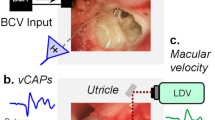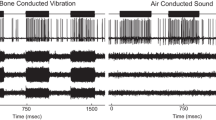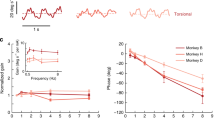Abstract
Vestibular evoked myogenic potentials (VEMPs) are routinely used to test otolith function, but which specific vestibular afferent neurons and central circuits are activated by auditory frequency VEMP stimuli remains unclear. To examine this question, we analyzed the sensitivity of individual vestibular afferents in adult Sprague–Dawley rats to tone bursts delivered at 9 frequencies (125–4000 Hz) and 3 intensity levels (60, 70, 80 dB SL re: acoustic brainstem response (ABR) threshold). Afferent neuron tone sensitivity was quantified by the cumulative probability of evoking a spike (CPE). Based on a threshold CPE of 0.1, acoustic stimuli in the present study evoked responses in 78.2 % (390/499) of otolith afferent neurons vs. 48.4 % (431/891) of canal afferent neurons. Organ-specific vestibular inputs to the central nervous system in response to tone bursts differ based on intensity and frequency content of the stimulus. At frequencies below 500 Hz, tone bursts primarily activated both otolith afferents, even at the highest intensity tested (80 dB SL re ABR threshold). At 1500 Hz, however, tone bursts activated the canal and otolith afferents at the moderate and high intensities tested (70, 80 dB SL), but activated only otolith afferents at the low intensity tested (60 dB SL). Within an end organ, diversity of sensitivity between individual afferent neurons correlated with spontaneous discharge rate and regularity. Examination of inner ear fluid mechanics in silico suggests that the frequency response and preferential activation of the otolith organs likely arise from inner ear fluid motion trapped near the oval and round windows. These results provide insight into understanding the mechanisms of sound activation of the vestibular system and developing novel discriminative VEMP testing protocols and interpretative guidelines in humans.





adopted from Marlinski et al. (2004)







Similar content being viewed by others
Change history
22 April 2022
A Correction to this paper has been published: https://doi.org/10.1007/s10162-022-00847-1
References
Ashford A, Huang J, Zhang C, Wei W, Mustain W, Eby T, Zhu H, Zhou W (2016) The cervical vestibular-evoked myogenic potentials (cVEMPs) recorded along the sternocleidomastoid muscles during head rotation and flexion in normal human subjects. J Assoc Res Otolaryngol 17(4):303–311. https://doi.org/10.1007/s10162-016-0566-8
Baird RA, Desmadryl GL, Femandez C, Goldberg JM (1988) The vestibular nerve of the chinchilla. II. Relation between afferent response properties and peripheral innervation patterns in the semicircular canals. J Neurophysiol 60:182–203
Broussard DM, Lisberger SG (1992) Vestibular input to brain stem neurons that participate in motor learning in the primate vestibuloocular reflex. J Neurophysiol 68:1906–1909
Carey JP, Hirvonen TP, Hullar TE, Minor LB (2004) Acoustic responses of vestibular afferents in a model of superior canal dehiscence. Otol Neurotol 25:345–352
Chen T, Huang J, Yu Y, Tang X, Zhang C, Xu Y, Arteaga A, Allison J, Mustain W, Donald MC, Rappai T, Zhang M, Zhou W, Zhu H (2021) Sound-evoked responses in the vestibulo-ocular reflex pathways of rats. Front Neurosci 15:741571. https://doi.org/10.3389/fnins.2021.74157
Colebatch JG (2001) Vestibular evoked potentials. Curr Opin in Neurol 14:21–26
Colebatch JG (2010) Sound conclusion? Clin Neurophysiol 121:124–126
Colebatch JG, Halmagyi GM (1992) Vestibular evoked potentials in human neck muscles before and after unilateral vestibular deafferentation. Neurology 42(8):1635–6
Contini D, Holstein GR, Art JJ (2020) Synaptic cleft microenvironment influences potassium permeation and synaptic transmission in hair cells surrounded by calyx afferents in the turtle. J Physiol 598(4):853–889. https://doi.org/10.1113/JP278680
Cullen KE, Rey CG, Guitton D, Galiana HL (1996) The use of system identification techniques in the analysis of oculomotor burst neuron spike train dynamics. J Comput Neurosci 3:347–368. https://doi.org/10.1007/BF00161093
Curthoys IS (2010) A critical review of the neurophysiological evidence underlying clinical vestibular testing using sound, vibration and galvanic stimuli. Clin Neurophysiol 121:132–144
Curthoys IS, Burgess AM, Goonetilleke SC (2019) Phase-locking of irregular guinea pig primary vestibular afferents to high frequency (>250 Hz) sound and vibration. Hear Res 373:59–70. https://doi.org/10.1016/j.heares.2018.12.009
Curthoys IS, MacDougall HG, Vidal PP, Waele CD (2017) Sustained and transient vestibular systems: a physiological basis for interpreting vestibular function. Front Neurol 8:117
Curthoys IS, Vulovic V (2011) Vestibular primary afferent responses to sound and vibration in the guinea pig. Exp Brain Res 210:347–52. https://doi.org/10.1007/s00221-010-2499-5
Curthoys IS, Vulovic V, Burgess AM, Sokolic L, Goonetilleke SC (2016) The response of guinea pig primary utricular and saccular irregular neurons to bone-conducted vibration (BCV) and air-conducted sound (ACS). Hear Res 331:131–143. https://doi.org/10.1016/j.heares.2015.10.019
Dlugaiczyk J, Gensberger KD, Straka H (2019) Galvanic vestibular stimulation: from basic concepts to clinical applications. J Neurophysiol 121(6):2237–2255. https://doi.org/10.1152/jn.00035.2019
Eatock RA, Songer JE (2011) Vestibular hair cells and afferents: two channels for head motion signals. Ann Rev Neurosci 34:501–534
Goldberg JM, Fernandez C (1975) Responses of peripheral vestibular neurons to angular and linear accelerations in the squirrel monkey. Acta Otolaryngol 80(1–6):101–110
Goldberg JM, Smith CE, Fernandez C (1984) Relation between discharge regularity and responses to externally applied galvanic currents in vestibular nerve afferents of the squirrel monkey. J Neurophysiol 51(6):1236–1256
Goldberg JM, Wilson VJ, Cullen KE, Angelaki DE, Broussard DM, Buttnwe-Ennever JA, Fukushima K, Minor LB (2012) Clinical manifestation of peripheral vestibular dysfunction. pp 495–524. In the vestibular system: a sixth sense. Oxford University Press
Grieser BJ, Kleiser L, Obrist D (2016) Identifying mechanisms behind the Tullio phenomenon: a computational study based on first principles. J Assoc Res Otolaryngol 17(2):103–118
Iversen MM (2021) Simple acoustic finite element model of rat inner ear: Input deck. Repository https://github.com/martaiversen/RatInnerEar_SimpleFEMAcousticModel
Iversen MM, Rabbitt RD (2017) Wave mechanics of the vestibular semicircular canals. Biophys J 113(5):1133–1149. https://doi.org/10.1016/j.bpj.2017.08.001
Iversen MM, Zhu H, Zhou W, Della Santina CC, Carey JP, Rabbitt RD (2018) Sound abnormally stimulates the vestibular system in canal dehiscence syndrome by generating pathological fluid-mechanical waves. Scientific Reports volume 8(10257)
Jombik P, Bahyl V (2005) Short latency responses in the averaged electrooculogram elicited by vibrational impulse stimuli applied upon the skull: could they reflect function of the vestibulo-ocular reflex? J Neurol Neurosurg Psychiatry 76:222–228
Lasker DM, Han GC, Park HJ, Minor LB (2008) Rotational responses of vestibular–nerve afferents innervating the semicircular canals in the C57BL/6 mouse. J Assoc Res Otolaryngol 9(3):334–348
Lin MY, Timmer FCA, Oriel BS, Zhou G, Guinan JJ, Kujawa SG, Herrmann BS, Merchant SN, Rauch SD (2006) Vestibular evoked myogenic potentials (VEMP) can detect asymptomatic saccular hydrops. Laryngoscope 116(6):987–992
Liu S, Angelaki DE (2009) Vestibular signals in macaque extrastriate visual cortex are functionally appropriate for heading perception. J Neurosci 28:8936–8945. https://doi.org/10.1523/JNEUROSCI.1607-09.2009
Lysakowski A, Goldberg JM (1997) A regional ultrastructural analysis of the cellular and synaptic architecture in the chinchilla cristae ampullares. J Comp Neurol 389(3):419–443
Marlinski V, Plotnik M, Goldberg JM (2004) Efferent actions in the chinchilla vestibular labyrinth. J Assoc Res Otolaryngol 5(2):126–143. https://doi.org/10.1007/s10162-003-4029-7
McCue MP, Guinan JJ (1994a) Acoustically responsive fibers in the vestibular nerve of the cat. J Neurosci 14:6058–6070
McCue MP, Guinan JJ (1994b) Influence of efferent stimulation on acoustically responsive vestibular afferents in the cat. J Neurosci 14:6071–6083
McCue MP, Guinan JJ (1995) Spontaneous activity and frequency selectivity of acoustically responsive vestibular afferents in the cat. J Neurophysiol 74:1563–1572
McCue MP, Guinan JJ (1997) Sound-evoked activity in primary afferent neurons of a mammalian vestibular system. Am J Otol 18:355–360
Minor LB, D Solomon D, Zinreich JS, Zee DS (1998) Sound- and/or pressure-induced vertigo due to bone dehiscence of the superior semicircular canal. Arch Otolaryngol Head Neck Surg 124(3):249–258
Money K, Bonen L, Weaver RS (1971) Physical properties of fluids and structures of vestibular apparatus of the pigeon. Am J Physiol 220(1):140–147
Murofushi T, Curthoys IS (1997) Physiological and anatomical study of click-sensitive primary vestibular afferents in the guinea pig. Acta Otolaryngol 117:66–72
Murofushi T, Curthoys IS, Topple AN, Colebatch JG, Halmagyi GM (1995) Responses of guinea pig primary vestibular neurons to clicks. Exp Brain Res 103:174–178
Parker DE, Tubbs RL, Littlefield VM (1978) Visual-field displacements in human beings evoked by acoustical transients. J Acoust Soc Am 63(6):1912–1918
Rabbitt RD, Boyle R, Highstein SM (1995) Mechanical indentation of the vestibular labyrinth and its relationship to head rotation in the toadfish, Opsanus tau. J Neurophysiol 73:2237–2260
Rabbitt RD, Brichta AM, Tabatabaee H, Boutros PJ, Ahn J, Della Santina CC, Poppi LA, Lim R (2016) Heat pulse excitability of vestibular hair cells and afferent neurons. J Neurophysiol 116(2):825–843. https://doi.org/10.1152/jn.00110.2016
Rajguru SM, Richter CP, Matic AI, Holstein GR, Highstein SM, Dittami GM, Richard D, Rabbitt RD (2011) Infrared photostimulation of the crista ampullaris. J Physiol 589(6):1283–1294
Rosengren SM, Welgampola MS, Colebatch JG (2010) Vestibular evoked myogenic potentials: past, present and future. Clin Neurophysiol 121:636–651
Simpson GV, Knight RT, Brailowsky S, Prospero-Garcia O, Scabini D (1985) Altered peripheral and brainstem auditory function in aged rats. Brain Res 348:28–35
Steer RW, Yao TL, Young LR , Meiry JL (1967) Physical properties of labyrinthine fluids and quantification of the phenomenon of caloric stimulation. Third symposium on the role of the vestibular organs in space exploration. Pensacola, FL Jan 23–27
Todd NPM, Cody FW, Banks JR (2000) A saccular origin of frequency tuning in myogenic vestibular evoked potentials?: implications for human responses to loud sounds. Hear Res 141(1–2):180–188. https://doi.org/10.1016/s0378-5955(99)00222-1
Todd NPM, Rosengren SM, Aw ST, Colebatch JG (2007) Ocular vestibular evoked myogenic potentials (OVEMPs) produced by air- and bone-conducted sound. Clin Neurophysiol 118:381–390
Tullio P (1929) Das Ohr und die Entstehung der Sprache und Schrift. Urban & Schwarzenberg, Berlin
Uchino Y, Kushiro K (2011) Differences between otolith- and semicircular canal-activated neural circuitry in the vestibular system. Neurosci Res 71(4):315–327
Uchino Y, Sasaki M, Sato H, Bai R, Kawamoto E (2005) Otolith and canal integration on single vestibular neurons in cats. Exp Brain Res 164:271–285
Ward BK, Roberts DC, Otero-Millan J, Zee DS (2019) A decade of magnetic vestibular stimulation: from serendipity to physics to the clinic. J Neurophysiol 121(6):2013–2019. https://doi.org/10.1152/jn.00873.2018
Wei W, Jeffcoat B, Mustain W, Xu Y, Eby T, Zhu H, Tang X, Zhou W (2013) Vestibular-evoked myogenic potentials (VEMP) recorded from different sites of the sternocleidomastoid muscles in normal human subjects. J Assoc Res Otolaryngol 14(1):37–47
Wilson VJ, Schor RH (1999) The neural substrate of the vestibulocollic reflex: what needs to be learned? Exp Brain Res 129:483–493
Wit HP, Bleeker JD, Mulder HH (1984) Responses of pigeon vestibular nerve fibers to sound and vibration with audio frequencies. J Acoust Soc Am 75(1):202–208
Xu Y, Simpson I, Tang X, Zhou W (2009) Acoustic clicks activate both the canal and otolith vestibulo-ocular reflex pathways in behaving monkeys. J Assoc Res Otolaryngol 10(4):569–577
Young ED, Fernandez C, Goldberg JM (1977) Responses of squirrel monkey vestibular neurons to audio-frequency sound and head vibration. Acta Otolaryngol 84:352–360
Zhang CM, Huang J, Xu Y, Mustain W, Zhu H, Zhou W (2016) Low frequency tone burst evokes a new positive peak (P2) in cervical VEMPs between the traditional P1–N1. ARO 39:286
Zhu H, Tang X, Wei W, Maklad A, Mustain W, Rabbitt R, Highstein S, Allison J, Zhou W (2014) Input-output functions of vestibular afferent responses to air-conducted clicks in rats. JARO 15:73–86
Zhu H, Tang X, Wei W, Xu Y, Mustain W, Zhou W (2011) Click-evoked responses in vestibular afferents in rats. J Neurophysiol 106(2):754–763
Zhou W, Weldon P, Tang B, King WM (2003) Rapid motor learning in the translational vestibulo-ocular reflex. J Neurosci 23(10):4288–4298. https://doi.org/10.1523/JNEUROSCI.23-10-04288.2003
Zhou W, Xu Y, Simpson I, Cai YD (2007) Multiplicative computation in the vestibulo-ocular reflex (VOR). J Neurophysiol 97:2780–2789
Funding
This study was supported by NIH R01DC012060 (HZ), NIH R01DC008585 (WZ).
Author information
Authors and Affiliations
Corresponding authors
Ethics declarations
Competing Interests
The authors declare no competing interests.
Additional information
Publisher's Note
Springer Nature remains neutral with regard to jurisdictional claims in published maps and institutional affiliations.
Wu Zhou and Hong Zhu share senior authorship of this paper.
Rights and permissions
About this article
Cite this article
Huang, J., Tang, X., Xu, Y. et al. Differential Activation of Canal and Otolith Afferents by Acoustic Tone Bursts in Rats. JARO 23, 435–453 (2022). https://doi.org/10.1007/s10162-022-00839-1
Received:
Accepted:
Published:
Issue Date:
DOI: https://doi.org/10.1007/s10162-022-00839-1




